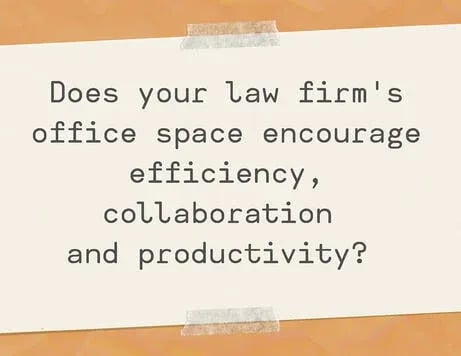It is becoming increasingly essential for law firms to be strategic when considering their workspace and design. As clients demand more value for their dollars spent, law firms must find ways to decrease overhead and maximize productivity - all while attracting and keeping the most talented lawyers. A law firm's office space is a prime area to focus these priorities.
A law firm needs to put more strategic thought into space planning if any of the following characteristics exist:
1. Lack of Connection to a Strategic Plan
Office space decisions in law firms are often reactionary and irrational. Because while most firm managers appreciate the materiality of cost, it is not unusual to see office space decisions guided more by impulse than by rational analysis and objective considerations. Landlords are also great a creating pressure to add space in advance of need because there is seemingly always someone who wants the adjacent offices. A never-ending cycle of too much or too little space is typical in poorly planned firms. New options such as remote work, office sharing, floating offices, more meeting rooms, smaller private areas, retrofitting existing spaces and others should be considered in an effort to find more cost-effective and strategically beneficial options.
2. Inefficient Space Utilization
It doesn’t take an expert to spot space inefficiencies in the typical law office. Law firms who don’t invest the time to project their spacing needs often accept whatever plan the building space planner offers. Because, after all, it is free. And easy. When this happens, law firm office space usually becomes disjointed, leaving some with too much space (way too much) and some with too little. Not only does this unorganized space appear sloppy, but it can also be damaging to morale. A lack of workspace or perception of unfair space allocation can cause frustration and dissonance. Not having strategic approach to space planning, a law firm can turn their work space into a negative competitive factor.
3. High Rent Cost Per Lawyer/Employee
Inefficient space allocation can lead to a high average square foot per employee, which will result in a high rent cost per employee, and in most cases, a high rent cost as a percent of revenue. As averages go, it is possible to score favorably on these financial metrics but experience material production losses from poor space allocation. For example: While large infrequently needed meeting rooms offer no economic benefit, legal assistants with properly designed workspaces can make a more productive atmosphere where they can accomplish more in less time. Poor space planning can result in more staff than necessary. Adding production inefficiencies to these metrics would tell a different story. Weak firms do not think in these terms and focus on office space as if it will somehow bend to the needs of the organization, which is hardly the reality.
4. Lack of Lease Flexibility
Lease flexibility is difficult but not impossible to achieve. Good lease consultants who take a firm through a strategic “what-if” analysis before negotiating lease terms do an excellent service for their clients. Most of the time, however, law firms deal with the agent broker for the building when making space decisions. Again, the building’s group is free, right? Unfortunately, their relationship with the building limits how hard they can or will negotiate for lease concessions. The right to lease additional space is easier to accomplish than obtaining the right to give space back. Law firms tend to spend heavily on buildout, so landlords need adequate security to advance these dollars. Poor planning processes do not consider the full range of options. Far too often, they are merely projections based on current events and belief their current prosperity will continue indefinitely.
5. Location Disadvantages
When considering office space, law firm rarely conduct any workforce analysis. In most settings, a firm either locates downtown or in the burbs. Locations close to courthouses and government buildings are a potential advantage, but there are other factors that should be considered. For example, where does the workforce live? A planned approach to facilities also considers commuting costs, time losses, quality of mass transit, weather-related office closings, desirability among talented lawyers, rental cost and available space, parking, quality of life, and convenience. Poor planning processes tend to view facilities decisions from a narrow viewpoint.

If your firm wants to be more strategic in making decisions, what are you waiting for? Contact PerformLaw right now to ensure that your law firm stands above the rest.
.webp?width=124&height=108&name=PerformLaw_Logo_Experts3%20(1).webp)

